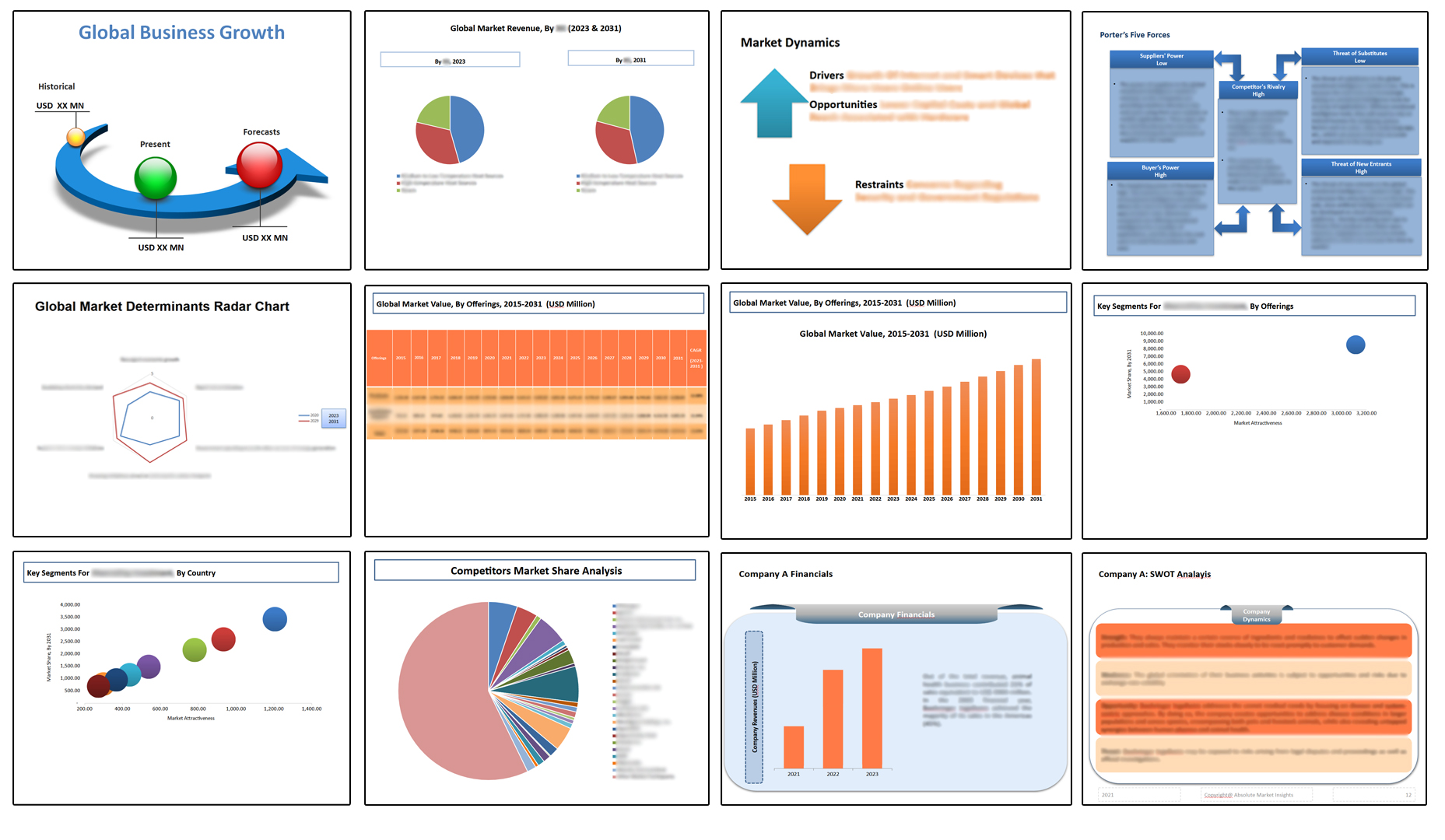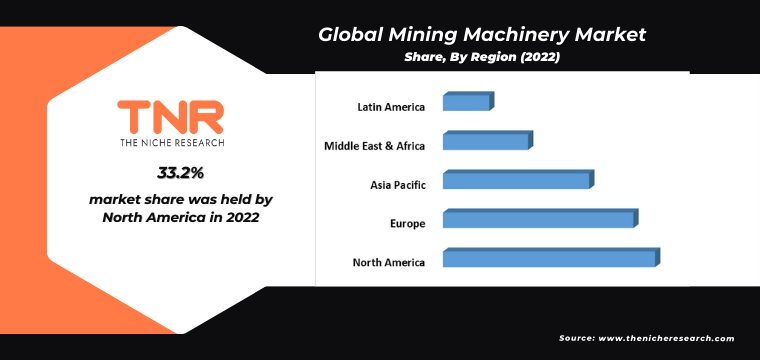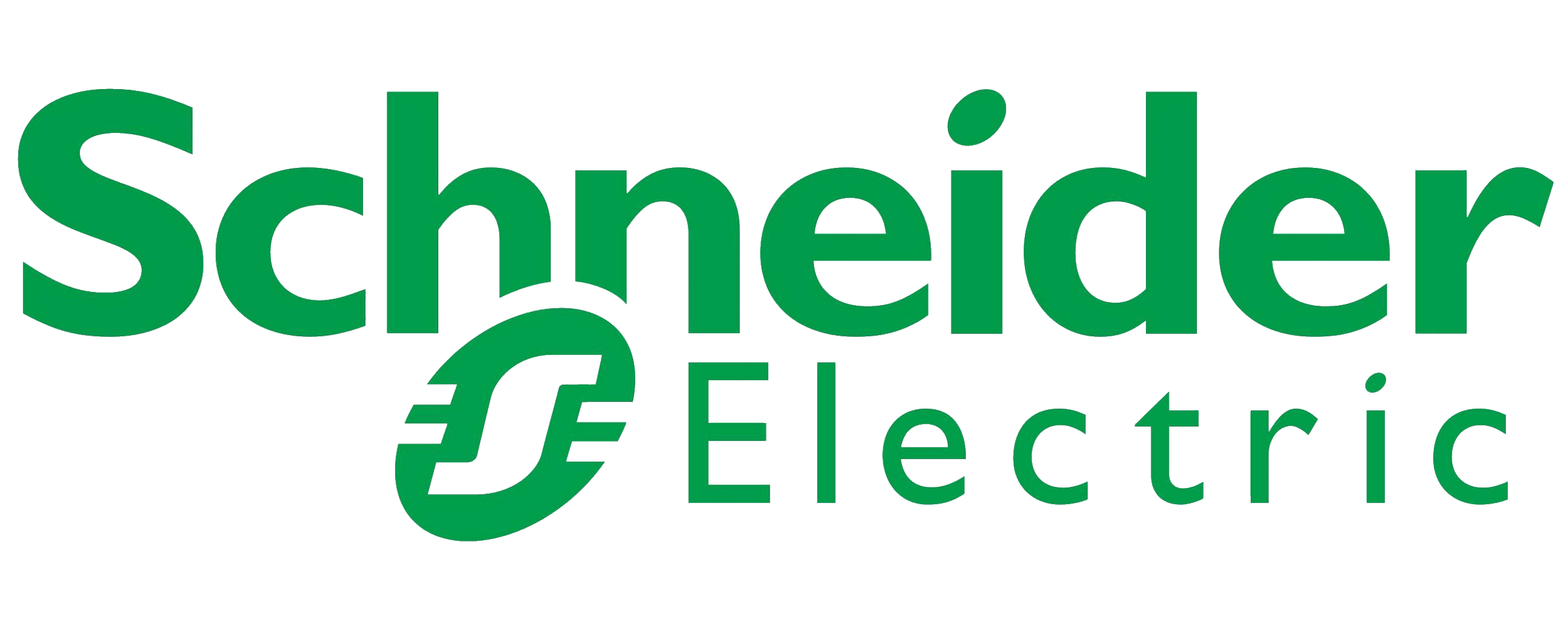Global Mining Machinery Market Insights, Growth, Share, Size: By Offerings, By Mining Type, By Powertrain Type, By Region & Segmental Forecast, 2023-2031, Comparative Analysis and Trends
- Industry: Construction & Manufacturing
- Report ID: TNR-110-969
- Number of Pages: 420
- Table/Charts : Yes
- November, 2023
- Base Year : 2024
- No. of Companies : 10+
- No. of Countries : 29
- Views : 10180
- Covid Impact Covered: Yes
- War Impact Covered: Yes
- Formats : PDF, Excel, PPT
Global Mining Machinery Market was Valued at USD 136.7 Bn in 2022, with an Estimated CAGR of 5.2% from 2023- 2031.
The adoption of Mining 4.0, which will alter the mining sector, has increased in recent years. A variety of technology breakthroughs have been achieved since the inception of the mining industry to address challenges such as mine safety for employees, equipment long-term viability and onsite and underground decision-making processes. The utilisation of cutting-edge mining machinery is expected to save time and money for operations.
Furthermore the integration of advanced technologies like automation, artificial intelligence (AI), data analytics, and remote control has improved the efficiency, safety, and productivity of mining operations, leading to increased demand for modernized machinery. Besides as mining companies are increasingly focused on sustainable and environmentally responsible practices. Modern mining machinery can be designed to minimize environmental impact, comply with regulations, and reduce emissions leading to the growth of the global mining machinery market.
Global Mining Machinery Market Revenue & Forecast, (US$ Million), 2015 – 2031

Global Mining Machinery Market Future
The future of the global mining machinery market is bright, with possibilities in the coal, mineral, and metal mining industries. The growth of mining activities and increased demand for metal and mineral products in emerging countries such as China and India are the primary drivers of this industry. Metal mining will remain the market’s largest application category, owing to increased demand from the construction and automotive industries.
Furthermore, growing demand for coal for power generation and rising metal consumption as a result of increased infrastructure building will keep Asia-Pacific as the world’s top consumer. The region’s growing population and urbanisation are producing significant economic prospects in the mining equipment sector.
Report Coverage and Deliverables

Global Mining Machinery Market Challenges
In order to remain competitive in the extremely complex mining sector, with intensive operations and a risk-prone and unpredictable working environment, various equipment maintenance issues need to be addressed. A poor mining machinery maintenance strategy might have substantial financial consequences. It might result in higher downtime, resulting in decreased productivity and income. Sudden equipment failure may necessitate quick repair, which may be more expensive than scheduled repair and maintenance.
Poorly maintained mining machinery that becomes unsafe to operate also increases safety hazards. Regardless of the investment, mining machinery breakdowns are unexpected and can occur at any time, resulting in production interruptions and significant financial losses. Thus the mining companies are investing into maintenance plans for the mining machinery for timely repair and maintenance. In the upcoming years the mining machinery market will upsurge due to the collaboration among industry market players to address these challenges.
Drills are an integral element of the underground mining process and are perhaps one of the most frequent pieces of mining equipment. Underground, specialised mining equipment such as trucks, loaders, diggers, and so on are used to unearth the material, which is then taken to the surface through skips or lifts for further processing. Drilling is typically necessary to install explosive charges in order to free minerals from overburden material. Underground mining techniques have advanced greatly in recent years, including the use of remote operated gear, which is boosting the mining machinery market demand.
 North America is continuously striving to advance in the mining industry as with the United States, Canada, and Mexico being prominent players in mineral extraction. The region’s industrial development, including construction, manufacturing, and infrastructure projects, requires significant quantities of raw materials obtained through mining, further fueling the demand for mining machinery. Furthermore the region has the presence of the prominent manufacturers of mining machinery in North America such as Caterpillar Inc., Komatsu Ltd., Joy Global Inc. (now part of Komatsu), and Sandvik AB. These companies provide a wide range of equipment, from excavators and loaders to drilling machinery and crushers. Thus all the above factors are supporting the growth of the mining machinery market in the North America.
North America is continuously striving to advance in the mining industry as with the United States, Canada, and Mexico being prominent players in mineral extraction. The region’s industrial development, including construction, manufacturing, and infrastructure projects, requires significant quantities of raw materials obtained through mining, further fueling the demand for mining machinery. Furthermore the region has the presence of the prominent manufacturers of mining machinery in North America such as Caterpillar Inc., Komatsu Ltd., Joy Global Inc. (now part of Komatsu), and Sandvik AB. These companies provide a wide range of equipment, from excavators and loaders to drilling machinery and crushers. Thus all the above factors are supporting the growth of the mining machinery market in the North America.
Competitive Landscape
The report also offers extensive research on the key players in the global mining machinery market and details on the competitiveness of these players. The competitive landscape of the mining machinery market is characterized by a mix of established players, technological innovators, and regional manufacturers. This landscape is dynamic, influenced by factors such as technological advancements, market demand, regulatory changes, and industry consolidation.
Key market participants operating in the global mining machinery market are
- AB Volvo
- Atlas Copco AB
- Caterpillar
- Fibo Intercon
- Liebherr Group
- Prairie Machine & Parts Mfg
- Sandvik AB
- SANY Group
- Scania AB
- SINOTRUK (HONG KONG ) LIMITED
- TAKRAF GmbH
- The Weir Group PLC
- Thyssenkrupp
- XCMG Machinery
- Other Industry Participants
Global Mining Machinery Market Report Coverage
| Report Specifications | Details |
| Market Revenue in 2022 | US$ 136.7 Billion |
| Market Size Forecast by 2031 | US$ 223.5 Billion |
| Growth Rate (CAGR) | 5.2% |
| Historic Data | 2015 – 2021 |
| Base Year for Estimation | 2022 |
| Forecast Period | 2023 – 2031 |
| Report Inclusions | Market Size & Estimates, Market Dynamics, Competitive Scenario, Trends, Growth Factors, Market Determinants, Key Investment Segmentation, Product/Service/Solutions Benchmarking |
| Segments Covered | By Offerings, By Mining Type, By Powertrain Type |
| Regions Covered | North America, Europe, Asia Pacific, Middle East & Africa, Latin America |
| Countries Covered | U.S., Canada, Mexico, Rest of North America, France, The UK, Spain, Germany, Italy, Nordic Countries (Denmark, Finland, Iceland, Sweden, Norway), Benelux Union (Belgium, The Netherlands, Luxembourg), Rest of Europe, China, Japan, India, New Zealand, Australia, South Korea, Southeast Asia (Indonesia, Thailand, Malaysia, Singapore, Rest of Southeast Asia), Rest of Asia Pacific, Saudi Arabia, UAE, Egypt, Kuwait, South Africa, Rest of Middle East & Africa, Brazil, Argentina, Rest of Latin America |
| Key Players | AB Volvo, Atlas Copco AB, Caterpillar, Fibo Intercon, Liebherr Group, Prairie Machine & Parts Mfg, Sandvik AB, SANY Group, Scania AB, SINOTRUK (HONG KONG ) LIMITED, TAKRAF GmbH, The Weir Group PLC, Thyssenkrupp, XCMG Machinery, Other Industry Participants |
| Customization Scope | Customization allows for the inclusion/modification of content pertaining to geographical regions, countries, and specific market segments. |
| Pricing & Procurement Options | Explore purchase options tailored to your specific research requirements |
| Contact Details | Consult With Our Expert
Japan (Toll-Free): – +81 663-386-8111 South Korea (Toll-Free): – +82-808- 703-126 Saudi Arabia (Toll-Free): – +966 800 850 1643 United States: +1 302-232-5106 United Kingdom: +447537105080 E-mail: askanexpert@thenicheresearch.com
|
Global Mining Machinery Market
By Offerings
- Products
- Excavators
- Mining Trucks
- Dragline
- Drills
- Bulldozers
- Crushers and Grinders
- Haulers
- Conveyors
- Others
- Services
By Mining Type
- Surface Mining
- Strip Mining
- Open Pit Mining
- Mountaintop Removal Mining
- Others
- Underground Mining
- Room and Pillar Mining
- Retreat Mining
- Blast Mining
- Placer Mining
- In-situ Mining
- Others
By Powertrain Type
- IC Engine Vehicle
- Electric Vehicle
By Region
- North America (U.S., Canada, Mexico, Rest of North America)
- Europe (France, The UK, Spain, Germany, Italy, Nordic Countries (Denmark, Finland, Iceland, Sweden, Norway), Benelux Union (Belgium, The Netherlands, Luxembourg), Rest of Europe)
- Asia Pacific (China, Japan, India, New Zealand, Australia, South Korea, Southeast Asia (Indonesia, Thailand, Malaysia, Singapore, Rest of Southeast Asia), Rest of Asia Pacific)
- Middle East & Africa (Saudi Arabia, UAE, Egypt, Kuwait, South Africa, Rest of Middle East & Africa)
- Latin America (Brazil, Argentina, Rest of Latin America)
Table of Contents
Note: This ToC is tentative and can be changed according to the research study conducted during the course of report completion.
**Exclusive for Multi-User and Enterprise User.
Global Mining Machinery Market Segmentation
Global Mining Machinery Market – Offerings Outlook
Global Mining Machinery Market –Mining Type Outlook
Global Mining Machinery Market – Powertrain Type Outlook
Global Mining Machinery Market – Regional Outlook
**Note: The report covers cross-segmentation analysis by region further into countries
The Niche Research approach encompasses both primary and secondary research methods to provide comprehensive insights. While primary research is the cornerstone of our studies, we also incorporate secondary research sources such as company annual reports, premium industry databases, press releases, industry journals, and white papers.
Within our primary research, we actively engage with various industry stakeholders, conducting paid interviews and surveys. Our meticulous analysis extends to every market participant in major countries, allowing us to thoroughly examine their portfolios, calculate market shares, and segment revenues.
Our data collection primarily focuses on individual countries within our research scope, enabling us to estimate regional market sizes. Typically, we employ a bottom-up approach, meticulously tracking trends in different countries. We analyze growth drivers, constraints, technological innovations, and opportunities for each country, ultimately arriving at regional figures.Our process begins by examining the growth prospects of each country. Building upon these insights, we project growth and trends for the entire region. Finally, we utilize our proprietary model to refine estimations and forecasts.
Our data validation standards are integral to ensuring the reliability and accuracy of our research findings. Here’s a breakdown of our data validation processes and the stakeholders we engage with during our primary research:
- Supply Side Analysis: We initiate a supply side analysis by directly contacting market participants, through telephonic interviews and questionnaires containing both open-ended and close-ended questions. We gather information on their portfolios, segment revenues, developments, and growth strategies.
- Demand Side Analysis: To gain insights into adoption trends and consumer preferences, we reach out to target customers and users (non-vendors). This information forms a vital part of the qualitative analysis section of our reports, covering market dynamics, adoption trends, consumer behavior, spending patterns, and other related aspects.
- Consultant Insights: We tap into the expertise of our partner consultants from around the world to obtain their unique viewpoints and perspectives. Their insights contribute to a well-rounded understanding of the markets under investigation.
- In-House Validation: To ensure data accuracy and reliability, we conduct cross-validation of data points and information through our in-house team of consultants and utilize advanced data modeling tools for thorough verification.
The forecasts we provide are based on a comprehensive assessment of various factors, including:
- Market Trends and Past Performance (Last Five Years): We accurately analyze market trends and performance data from preceding five years to identify historical patterns and understand the market’s evolution.
- Historical Performance and Growth of Market Participants: We assess the historical performance and growth trajectories of key market participants. This analysis provides insights into the competitive landscape and individual company strategies.
- Market Determinants Impact Analysis (Next Eight Years): We conduct a rigorous analysis of the factors that are projected to influence the market over the next eight years. This includes assessing both internal and external determinants that can shape market dynamics.
- Drivers and Challenges for the Forecast Period:Identify the factors expected to drive market growth during the forecast period, as well as the challenges that the industry may face. This analysis aids in deriving an accurate growth rate projection.
- New Acquisitions, Collaborations, or Partnerships: We keep a close watch on any new acquisitions, collaborations, or partnerships within the industry. These developments can have a significant impact on market dynamics and competitiveness.
- Macro and Micro Factors Analysis:A thorough examination of both macro-level factors (e.g., economic trends, regulatory changes) and micro-level factors (e.g., technological advancements, consumer preferences) that may influence the market during the forecast period.
- End-User Sentiment Analysis: To understand the market from the end-user perspective, we conduct sentiment analysis. This involves assessing the sentiment, preferences, and feedback of the end-users, which can provide valuable insights into market trends.
- Perspective of Primary Participants: Insights gathered directly from primary research participants play a crucial role in shaping our forecasts. Their perspectives and experiences provide valuable qualitative data.
- Year-on-Year Growth Trend: We utilize a year-on-year growth trend based on historical market growth and expected future trends. This helps in formulating our growth projections, aligning them with the market’s historical performance.
Research process adopted by TNR involves multiple stages, including data collection, validation, quality checks, and presentation. It’s crucial that the data and information we provide add value to your existing market understanding and expertise. We have also established partnerships with business consulting, research, and survey organizations across regions and globally to collaborate on regional analysis and data validation, ensuring the highest level of accuracy and reliability in our reports.















